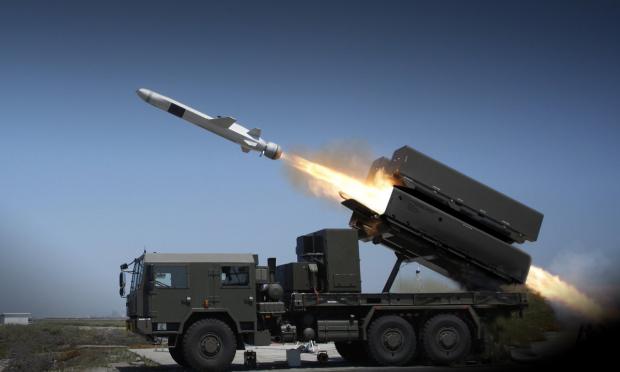It is an indisputable fact that the NASAMS anti-aircraft system is responsible for many downings of Russian aerial vehicles in military operations in Ukraine, which has drawn rave reviews from Kyiv.
The above resulted in Russia looking for ways to destroy it, in order to make the bombing of Ukrainian targets easier and less bloody.
This seems to have finally been achieved, according to an article by a reputable International Media, entitled "Russian Army destroys NASAMS air defense systems for the first time in Ukraine", the highlights of which are as follows:
"On February 3, the Russian Ministry of Defense (RuMoD) claimed that its military had finally managed to destroy the US-supplied NASAMS air defense system months after it was deployed by the Ukrainian military.
Although these claims remain unverified, they were widely reported by local Russian media.
"A Tochka-U tactical missile launcher and a Norwegian-made NASAMS anti-aircraft missile system were destroyed in the settlement of Krasnoarmeysk in the Donetsk People's Republic," RIA Novosti reported citing the Russian Defense Ministry.
Russian missile attacks against Ukraine have intensified in recent weeks as Ukraine continues to secure more lethal aid from NATO countries. A new barrage of rockets hit the city of Kramatorsk in eastern Ukraine, hitting residential buildings.
Moscow has often criticized the West for supplying military equipment to Ukraine and issued a stern warning that the move amounted to "playing with fire". Russian officials have also warned on multiple occasions that these systems could become a legitimate target for attack by Russian troops.
Ukrainian troops have deployed the highly accurate National Advanced Surface-to-Air Missile Systems (NASAMS). The Norwegian-made system, which was delivered to Ukraine in November last year, effectively shoots down Russian cruise missiles and kamikaze drones.
In addition to the two arrays delivered by Washington, Kyiv is also hoping to secure this state-of-the-art air defense system from other NATO countries.
Last month, Canadian Prime Minister Justin Trudeau said Canada would provide an American-made National Advanced Surface-to-Air Missile System (NASAMS) to Ukraine.
The Kremlin criticized the decision, accusing Ottawa of funneling money to fuel the war in Ukraine.
However, Ukraine is also set to receive an even more lethal PAC-3 Patriot anti-missile defense system that will protect its cities from Russian ballistic missiles.
Additionally, the Russian claims of NASAMS destruction come weeks after Raytheon Technologies CEO Greg Hayes said last month that U.S. officials were in talks with NATO and Middle East allies to send anti-aircraft NASAMS from the their respective stocks, in Ukraine.
"The Department of Commerce is going to try to do some deals for us where we're going to take some of the Middle Eastern countries that are our friends and some of our NATO allies and try to bring them to Ukraine early next year," said the CEO.
"We will then ship new products to those countries over the next two years."
Arguing for used NASAMS to be delivered to Ukraine, Hayes said that redirecting these air defense systems from third countries to Kyiv would be faster than building them.
"Just because it takes 24 months to build doesn't mean it will take 24 months to get to the country," he said.
However, for any transfer of air defense systems from a third country to Ukraine to take place, it must be approved by the Biden administration.
NASAMS strengthened Ukrainian defenses
US Defense Secretary Lloyd Austin said earlier that NASAMS had a 100% success rate in Ukraine and was effectively deterring Russian attacks. The US has so far delivered two of the eight NASAMS arrays promised to Ukraine last year.
The system, developed by Kongsberg Defense of Norway and Raytheon of the US, is the first ground-based short-to-medium range air defense system.
As a result of its deadly accuracy, even the US is deploying NASAM to protect the sensitive airspace surrounding the White House and the US Capitol in Washington.
This system has some advanced features, such as interoperability-based design, addressing multiple simultaneous threats beyond visual range (BVR) capabilities, and can be closely integrated and tailored to a country's integrated air and missile defense (IAMD) system.
NASAMS is a defense system designed to prevent attacks on high-value targets by drones, helicopters, cruise missiles and aircraft.
For this, it uses AIM-120 AMRAAM air-to-air missiles, which have been modified for ground launch and have an engagement range of about 30 kilometers.
Ukraine has likely received the NASAMS-2 variant, which has a Link-16 data link and can be guided to the target by an airborne surveillance asset such as the E-3 Sentry AWACS, which monitors Ukrainian airspace.
As previously noted by the EurAsian Times, this significantly distinguishes NASAMS from most air defense systems currently in use by Ukrainian forces that cannot utilize the E-3 capability.
In addition, NASAMS can also be mounted on HIMARS, which has become Ukraine's most formidable weapon against Moscow. "
What is changing in the Ukrainian air defense?
If Russian claims about the destruction of NASAMS in Ukraine are true, it could be a major development for war-torn Ukraine, which has only two of these systems and is currently facing a relentless Russian missile attack.
A US-NATO solution to the Ukrainian air defense should be found immediately, since based on existing military indications, a large-scale Russian attack is imminent, which will certainly be accompanied by a barrage of missile and drone attacks.
The West should run in time to reinforce Ukraine, before it is too late, since in our estimation, as the war is progressing, the next 6 months will be the most decisive and possibly the last in the war, with the most likely victory of Russia



